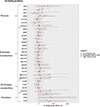Hair product use and urinary biomarker concentrations of non-persistent endocrine disrupting chemicals among reproductive-aged Black women
- PMID: 38810806
- PMCID: PMC11217908
- DOI: 10.1016/j.chemosphere.2024.142442
Hair product use and urinary biomarker concentrations of non-persistent endocrine disrupting chemicals among reproductive-aged Black women
Abstract
Background: Studies have shown an association between hair product use and adverse health outcomes. Scientists have hypothesized that exposure to endocrine-disrupting chemicals (EDCs) drives these associations, but few studies have directly evaluated associations between hair product use and biomarkers of EDCs. Even more limited are studies of Black women, who frequently use EDC-containing products (e.g., hair relaxers).
Objective: We estimated associations between hair product use and EDC biomarker concentrations.
Methods: We leveraged cross-sectional data from the Study of Environment, Lifestyle, and Fibroids, a cohort of females aged 23-34 years who self-identified as Black/African American from the Detroit-metropolitan area (USA; n = 425). On structured questionnaires, participants reported their past 24-h and past 12-month use of hair products, including relaxers/straighteners/perms, styling products, moisturizers, oils, and hair food. We quantified urinary concentrations of 19 phthalate/phthalate alternative metabolites, 7 phenols, and 4 parabens using high performance liquid chromatography isotope dilution tandem mass spectrometry. EDC biomarker concentrations were creatinine-adjusted and natural log-transformed. We used multivariable linear regression to estimate mean percent differences in EDC biomarker concentrations and 95% confidence intervals (CIs) associated with hair product use, adjusting for sociodemographic confounders.
Results: Hair product use was associated with greater concentrations of multiple EDC biomarkers. Notably, use of hair products in the previous 24 h (compared with non-use) was associated with 16.2% (95% CI = 0.7%, 35.9%), 35.0% (95% CI = 2.6%, 77.6%), and 32.3% (95% CI = 8.8%, 92.0%) higher concentrations of mono-isobutyl phthalate, methyl paraben, and ethyl paraben, respectively. Use of hair relaxers/straighteners/perms, styling products, moisturizers, oils, and hair food in the past 12 months was also associated with higher concentrations of multiple phthalate, phenol, and paraben biomarkers.
Conclusion: Hair product use was associated with higher biomarker concentrations of multiple phthalates, phenols, and parabens. These findings suggest that hair products are potentially important exposure sources for hormonally-active chemicals among Black women.
Keywords: EDCs; Hair products; Parabens; Phenols; Phthalates; Women.
Copyright © 2024 Elsevier Ltd. All rights reserved.
Conflict of interest statement
Declaration of competing interest The authors declare that they have no known competing financial interests or personal relationships that could have appeared to influence the work reported in this paper.
Figures






Similar articles
-
Associations of urinary biomarkers of phthalates, phenols, parabens, and organophosphate esters with glycemic traits in pregnancy: The Healthy Start Study.Environ Res. 2024 Dec 1;262(Pt 1):119810. doi: 10.1016/j.envres.2024.119810. Epub 2024 Aug 16. Environ Res. 2024. PMID: 39155036
-
Phenol biomarker concentrations in human ovarian follicular fluid and the associations with in-vitro fertilization outcomes.Int J Hyg Environ Health. 2025 Jul;268:114617. doi: 10.1016/j.ijheh.2025.114617. Epub 2025 Jul 4. Int J Hyg Environ Health. 2025. PMID: 40617121
-
Parabens, bisphenols, and other environmental phenols exposure from cosmetics use in Korean adolescent girls: Findings from a 2-day intervention study.Environ Res. 2025 Oct 1;282:122039. doi: 10.1016/j.envres.2025.122039. Epub 2025 May 30. Environ Res. 2025. PMID: 40451416
-
Systematic Review of the Epidemiology of Hair Relaxer Use and Hormone-Sensitive Reproductive Outcomes Among Black Adult Women in the United States.J Appl Toxicol. 2025 Aug;45(8):1394-1416. doi: 10.1002/jat.4744. Epub 2025 Jan 19. J Appl Toxicol. 2025. PMID: 39828620
-
Heated tobacco products for smoking cessation and reducing smoking prevalence.Cochrane Database Syst Rev. 2022 Jan 6;1(1):CD013790. doi: 10.1002/14651858.CD013790.pub2. Cochrane Database Syst Rev. 2022. PMID: 34988969 Free PMC article.
Cited by
-
Engaging, recruiting, and retaining pregnant people from marginalized communities in environmental health cohort studies: a scoping review.BMC Public Health. 2025 Mar 7;25(1):908. doi: 10.1186/s12889-025-22033-7. BMC Public Health. 2025. PMID: 40050851 Free PMC article.
-
Personal care product use and risk of adult-onset asthma: Prospective cohort analyses of U.S. Women from the Sister Study.Environ Int. 2025 Aug;202:109681. doi: 10.1016/j.envint.2025.109681. Epub 2025 Jul 11. Environ Int. 2025. PMID: 40779943
References
-
- Baird DD, Harmon QE, Upson K, Moore KR, Barker-Cummings C, Baker S, Cooper T, Wegienka G, 2015. A Prospective, Ultrasound-Based Study to Evaluate Risk Factors for Uterine Fibroid Incidence and Growth: Methods and Results of Recruitment. J Womens Health 24, 907–915. 10.1089/jwh.2015.5277 - DOI - PMC - PubMed
MeSH terms
Substances
Grants and funding
LinkOut - more resources
Full Text Sources
Miscellaneous

